On July 25th 1944, the 1st US Army under the command of Lieutenant-General Omar Bradley launched Operation Cobra, the destruction of the German lines once and for all in Normandy. Indeed, the American Army was fighting since D-Day, since one month and a half in this area of France. The landscape, the famous hedgerows forced the Americans to fight field-by-field, ditch-by-ditch and the shadow of a new WWI arose. More so it was impossible to launch the armored divisions, the Normandy landscape wasn’t and still isn’t an open country. This is why Operation Cobra took place.
Despite the friendly fire on July 25th, which caused approximately 1000 US casualties, German lines have been broken. The 2nd Armored Division, which landed at Omaha Beach on June 9th, operated in the area and was part of Operation Cobra. Its mission? Prevent the Germans to re-establish a line of defense.
The infamous SS soldiers of the 2nd “Das Reich” Panzer Division, the paratroopers of the 6th Fallschirmjäger Regiment and the infantrymen of the 17th Panzergrenadier Division had become the shadow of what they were one month ago, battle hardened soldiers. Despite the success of Operation Cobra and the withdrawal of the German troops to the south of Normandy, the enemy launched a counterattack toward Cerisy-la-Salle and directed at Le Pont-Brocard and Notre-Dame-de-Cenilly on July 28th, 1944. Precisely during the night of the 29th to the 30th the enemy surprised the soldiers of “E” Company of the 2nd Battalion of the 67th Armored Regiment under the command of Captain James R. McCartney and “I” Company of the 3rd Battalion of the 41st Armored Infantry Regiment commanding by Captain Walter C. Johnson.
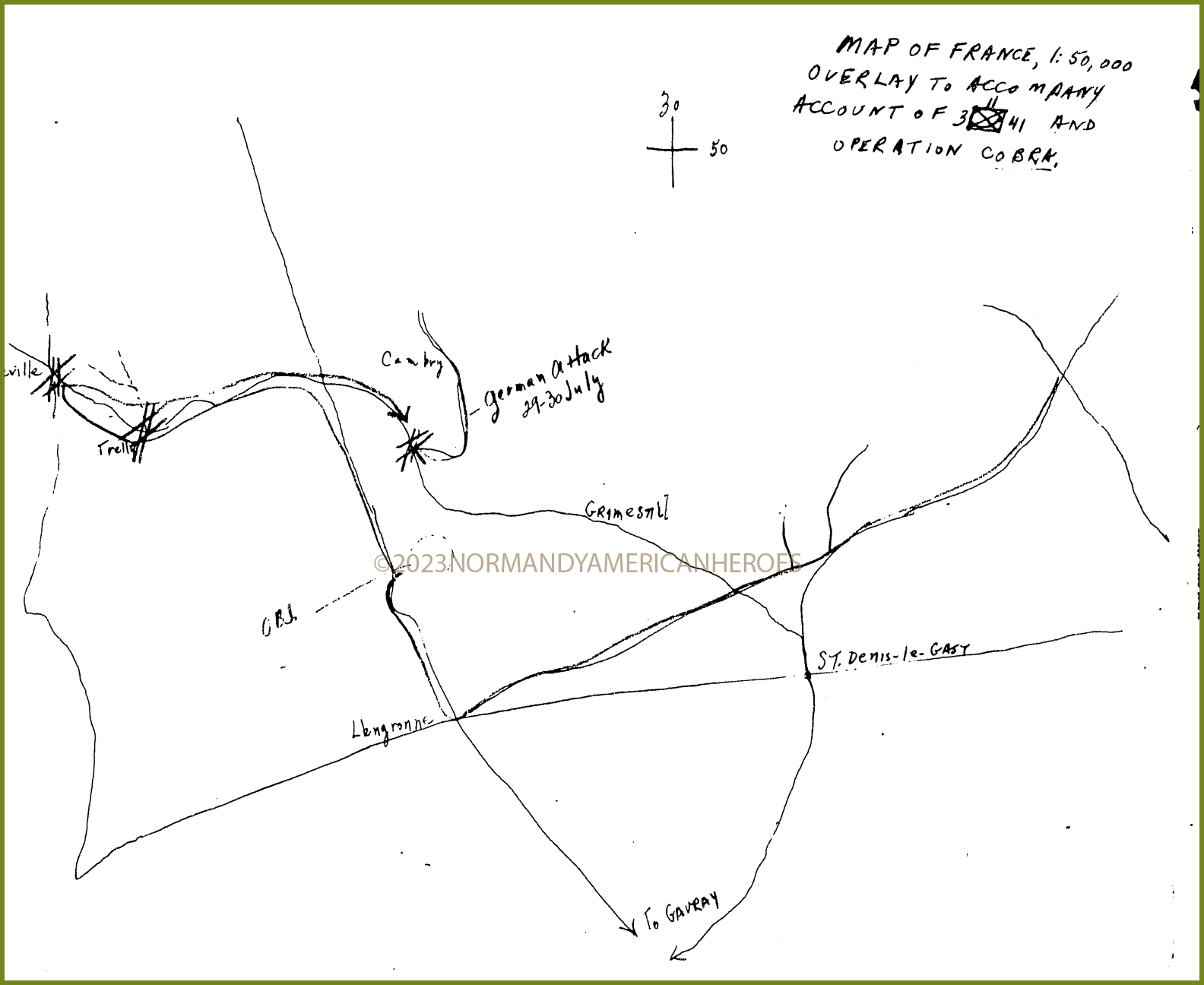
On July 29th “I” Company was assigned the mission to defend the crossroad at coordinates 346469 (see map below) and in the early hours of the 30th it will leave the position. “I” Company was part of the task force with “E” Company of the 67th Armored Regiment commanded by Lieutenant-Colonel John D. Wynne.
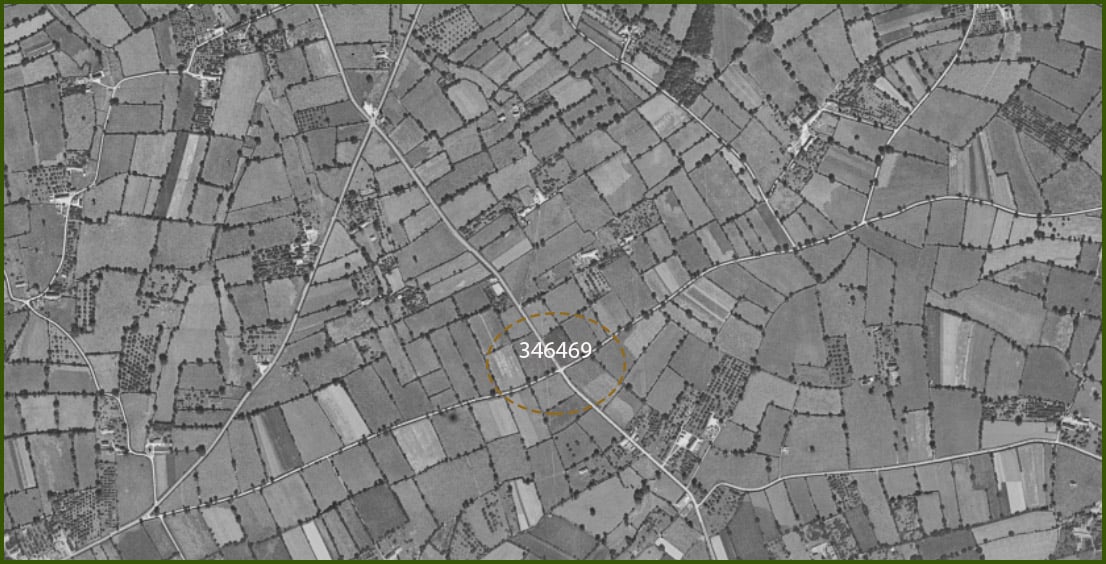 ©IGNMap - Remonter le temps.
©IGNMap - Remonter le temps.
Note: The area around the crossroad was divided in three sectors, each sector was defended by a platoon of tanks and infantry men.
First, Captain Johnson sent a patrol to the crossroad at coordinates 341476 to make a connection with the men of the 1st Platoon of “A” Company of the 41st Armored Infantry Regiment. Connection was made and the patrol came back. Both units had to defend the crossroad at coordinates 346469 (see map above), for the purpose one platoon of tanks and one platoon of infantrymen were placed in a square defense around it.
Around 0350am on July 29th a report came stating that a column of thirty enemy vehicles with a self-propelled 88mm gun coming from the direction of the village of Roncey has been spotted, (see map below) heading toward the position of “I” Company. Germans were smart; indeed, the enemy was rolling down the hill toward coming from the Grimesnil road with the engines of the vehicles off. Hopefully for the boys of the 2nd Armored Division, they had already set up a roadblock but not completely when the Germans attacked. A mortar barrage was laid, then the 88mm gun took over and overran “I” Company’s positions.
Note: The enemy gunner would be killed by Sergeant Lotz (AAR Spelling).
When the 88mm gun was finally silenced, the enemy troops launched their attack by yelling “Heil Hitler”. A lot of casualties were encountered among the US troops, Lieutenant Anderson Commanding Officer of one platoon of “I” Company of the 41st Armored Regiment was cut off from the other units when the enemy took position at the bend and started east on the road.
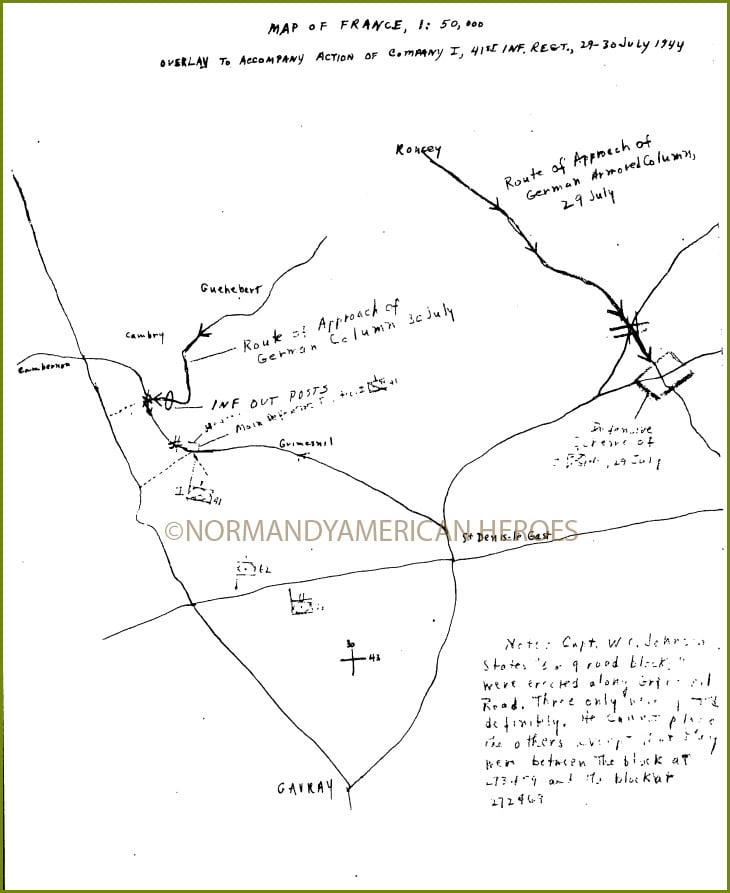
The body of Lieutenant Anderson was not recovered, and according to Lieutenant-Colonel Marshall L. Crawley, he was not taken prisoner. Why? “Lieutenant Anderson would not be taken prisoner”.
Note: The main support was coming from the artillery and tanks, Captain Johnson was directing the fire.
Thanks to the support of the tanks and artillery, a small counterattack took place and the crossroad was held. The enemy then tried to create a flanking eastward attack but failed.
In the meantime, Lieutenant-Colonel Crawley maintained a roadblock at Ecaudeville but no action took place at that time on his position. Being aware of the enemy counterattack upon friendly troops, at 0500am on July 30th he moved as quick as possible onto the Grimesnil road by taking “H” Company of the 3rd Battalion of the 41st Armored Regiment with him.
Arriving two hours later, at 0700am things had quiet down and only small arms fire were taking place. “Every time you’re fighting like that, it’s terrific for several hours and then all of a sudden everything stops”, said Captain Johnson.
Patrols of “H” Company were sent to scout out the situation at the crossroad, but no surprise, it was out, making contact with “I” Company impossible.
At that moment the only matter was to make contact with the boys of “I” Company, Lieutenant-Colonel Crawley went down the road toward the south and was caught by a friendly fire from the tanks of the 4th Armored Division. Yellow flares were fired but in vain, tanks increased their fire thinking they were enemy troops and it only stopped when the Lieutenant-Colonel finally made radio contact. All of the sudden “H” Company made three-hundred prisoners, mostly from SS units. The US Army used of its greatest assets which was the artillery. Germans retreated leaving behind them seventeen dead and fifty wounded.
Once the battle for the crossroad over, the new mission of “I” Company was to take position at the road junction at Cambernon then to establish contact with Major William P. Ring Jr. in command of a tank force. On its way toward its new objective “I” Company’s boys encountered sniper fire, especially around Grimesnil.
In case of a new enemy attack seven or eight roadblocks were set up on all of the crossroads between the villages of Grimesnil and Cambernon. At coordinates 279460 a sunken trail forms a V-shape from the south to join the Grimesnil road, this is why a platoon of tanks supported by infantry men were placed, composing the main line of defense.
Note: Command Post of “I” Company was set up on that sunken trail.
What was about to happen, happened. An enemy armored column with a self-propelled 75mm gun and another self-propelled gun but this time a 170mm, were spotted by an outpost of “I” Company.
Men fell back and relayed the information to their platoon leader, Lieutenant Fraze (AAR Spelling). Once the conversation between Lieutenant Fraze and his men over, the enemy opened fire upon them destroying his command half-track and killing the radio operator but worse the communication lines between his platoon and the rest of the company were cut off.
Note: Germans manning the guns were not very confident because they knew that they would become the main targets of the artillery (78th and 62nd Armored Field Artillery Battalions), which opened fire one hour after the first call for a support has been made.
The artillery opened fire one hour later because of many reasons:
- When Captain Johnson called for an artillery support he heard over the radio "Baker Battery fire direct" which means guns of the 78th were already engage in another fight.
- The number of friendly troops fighting in this narrow area was so huge, Combat Command "B" had to take time to give permission or not to use the artillery, the risk of a friendly fire was too high.
The first fire delivered by the artillery was right on the targets and their success in hitting the road was phenomenal in view of all the friendly troops and vehicles in the around and in the area.
While the battle was taking place, Sergeant Hulon Brocke Whittington did a heroic action. Having his platoon leader missing in action and his platoon sergeant wounded, Sergeant Whittington took over his platoon by assuming command, set up an aid station and smoothed out the system of evacuating the wounded.
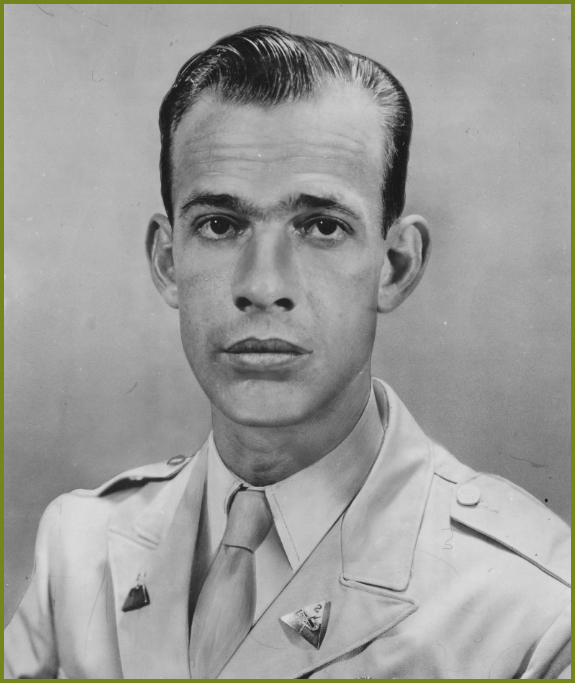 ©CongressionalMedalofHonorSociety.
©CongressionalMedalofHonorSociety.
In addition he made a perilous trip across the road to the hedgerow lining the field where the main defensive position was maintained, learning that many of the men were pinned down along the hedgerow, he rode up to the hedgerow on top of a tank with a number of grenades and proceeded to blast out the enemy almost one by one.
During the time period of July 29th to the 30th, “I” Company suffered sixteen men killed, twenty-five wounded and two missing in action. Four half-tracks have been knocked out but it was the Germans who suffered the greatest number of casualties, one-thousand have been killed and one-hundred vehicles have been lost.
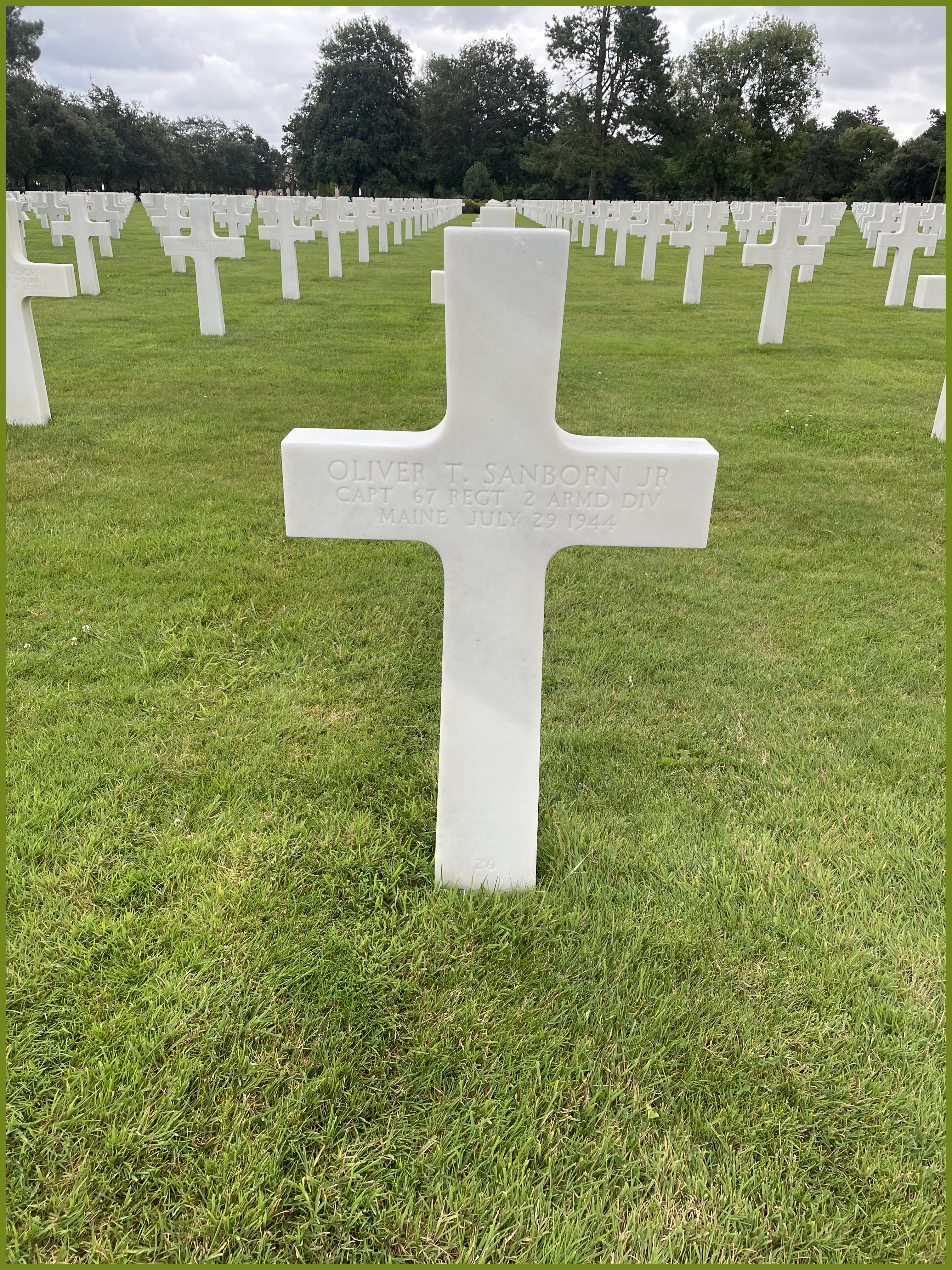 Oliver T. Sanborn Jr is buried at the Normandy American Cemetery Plot E - Row 28 - Headstone 26 and paid the ultimate sacrifice fighting on the Grimsenil road.
Oliver T. Sanborn Jr is buried at the Normandy American Cemetery Plot E - Row 28 - Headstone 26 and paid the ultimate sacrifice fighting on the Grimsenil road.
After the two days battle, Captain Johnson stated: “I got a silver star of out of it a couple days ago, but hell, I was just there, the other boys did the fighting”.
Written by Pierre Fallet.

















